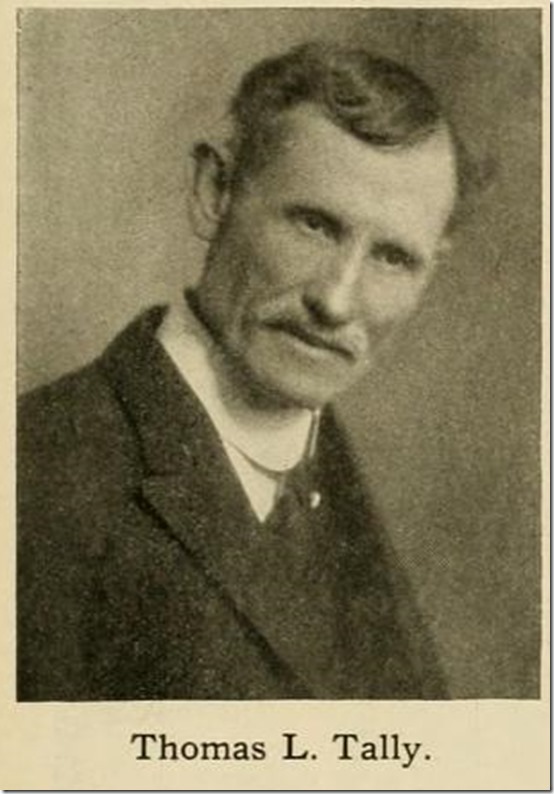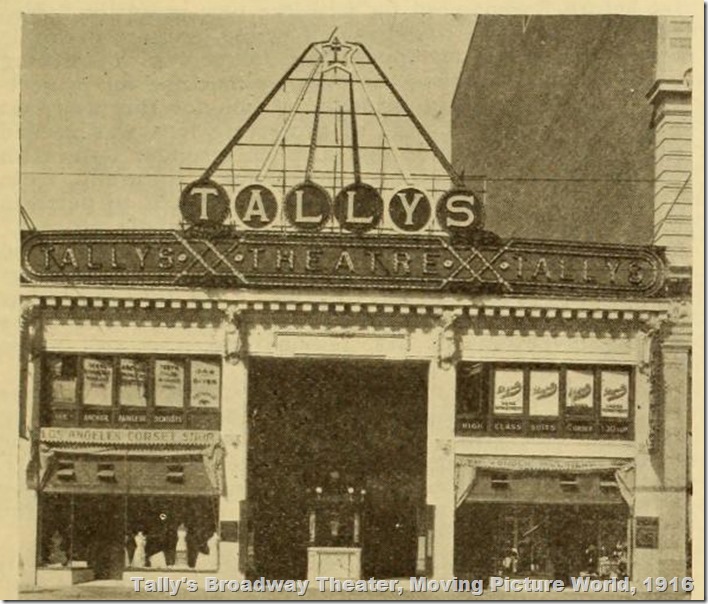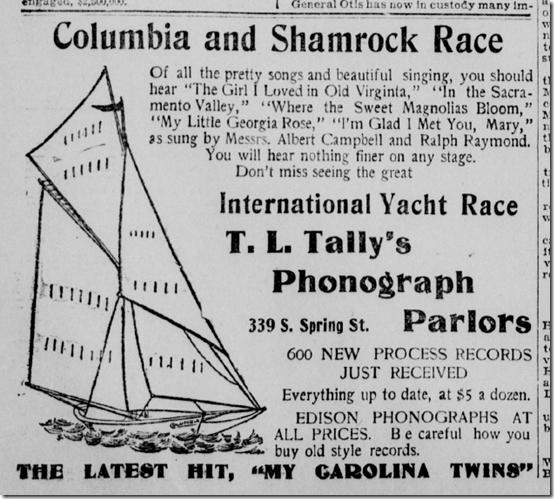
T.L. Tally, Moving Picture World, 1915.
Los Angeles has stood at the forefront of not only motion picture production, but the fields of exhibition and distribution as well. Former Texan T. L. (Thomas Lincoln) Tally pioneered in these fields, seeming to anticipate changes in the marketplace during the early decades of the Twentieth Century. Shrewd and risk-taking, Tally earned a fortune entertaining the citizens of Los Angeles, introducing several firsts to the city, including the first theatre built exclusively to show motion pictures and the first to cause a nitrate fire. As early as the 1920s, articles and books proclaim him as the pioneer exhibitor in Los Angeles, but “printing the legend” instead of the facts as to when he entered the moving picture business.
Little is known of his early life, save that Tally was born July 6, 1862, in Rockport, Texas (per ship passenger logs). By 1890 he resided in San Antonio per the March 26, 1890, San Antonio Daily Express and first visited Los Angeles in April, when the April 6, 1890, Los Angeles Herald lists him as a guest at the permanent exhibit of California on Wheels.
Hollywood at Play, by Donovan Brandt, Mary Mallory and Stephen X. Sylvester is now on sale.

T.L. Tally in his Phonograph Parlor in San Antonio in 1893, International Photographer.
Tally perhaps discovered his fascination with the mechanical reproduction of sound, film, and other products when he visited the 1893 Chicago World’s Exposition, perhaps seeing the demonstration of Thomas Edison’s Kinetophone, which married motion picture film and sound for the first time. At the same time, sounds emanating from the phonograph gave him a thrill, introducing famous singers and their world-renowned voices. Savvy and entrepreneurial and enamored of the new technologies, he returned to San Antonio as the city’s representative of Edison Phonographs, opening a Phonograph Parlor to introduce the new and exciting product to the state of Texas. Phonographs allowed average people to hear great singers and performers warbling the latest and greatest song hits, as well as providing a unique form of entertainment.
Over the next few years, Tally visited both Santa Monica and Los Angeles per news records, setting up Phonograph Parlors in Santa Monica and a business at 245 S. Spring Street in downtown Los Angeles, focusing on businessmen and immigrants for his early business. Perhaps Tally visited Peter Bacigalupi’s Kinetoscope Parlor, falling in love with the visual presentation of moving pictures and the dreamlike world they offered. Bacigalupi, the sole California representative of Edison products like the wondrous Kinetoscope, was born in New York City and moved to San Francisco as a young man before immigrating to Peru and becoming prosperous promoting trade photos, acting as a Remington typewriter agent, and selling other products. He returned to San Francisco in the early 1890s and established Phonograph Parlors there before setting up his Edison Phonograph Parlor at 206 S. Spring Street in downtown Los Angeles, and later a combined Phonograph and Kinetoscope Parlor as well, which allowed individual viewers to watch a short film by turning a knob and watching images on a small screen in a cabinet.

T.L. Tally in his movie parlor at 311 S. Spring St. in Los Angeles, which opened in August 1896, according to International Photographer, 1932.
“At the rear center are two chairs facing an Edison peepshow on the screen. At the left side of the picture are the Edison kinematographs, in the center Biograph mutoscopes, and at the right the customers are listening to phonographs.”
Bacigalupi purchased a December 24, 1894 ad in the Los Angeles Herald inviting citizens to come see Edison’s great invention, the first time motion pictures appear to be advertised and exhibited in the city. He advertised the first screening of a moving picture film in Los Angeles with his September 25, 1895 Los Angeles Herald advertisement stating that he is the sole California Edison representative for “enlarged and improved Kinetoscopes,” announcing “Corbett vs. Courtney prize fight, six furious rounds and knockout, will be on exhibition for a short time only at 248 S. Spring Street; 5 cents per round or six rounds 30 cents.”
Overwhelmed attempting to operate and manage Phonograph and Kinetoscope Parlors in Los Angeles and San Francisco, Bacigalupi sold his downtown Los Angeles parlor to the ambitious Tally and moved back to the City by the Bay. Showman and huckster Tally went all out promoting his new acquisition, buying an October 8, 1895, Los Angeles Herald ad stating, “Expert phonograph and exhibitor of east who has been located at 245 S. Spring St. bought Corbett fight to show at new parlor at 248 S. Spring.” Tally appeared to have acquired a Vitascope to add to his Kinetoscopes, Mutoscope, Phonographs, and peep shows, with a July 25, 1896, ad stating that images would be displayed on a “great screen,” just a week after the Vitascope’s first performance at the Orpheum theatre downtown. This would enable the huckster to promote both New York’s greatest song hits and amazing moving pictures to enthralled audiences.

An ad for Edison’s Projectoscope at Tally’s Phonograph Parlor, 311 S. Spring St., Los Angeles Herald, Sept. 30, 1898.
Tally moved all his business to downtown Los Angeles by fall 1896, as the September 15, 1896, Los Angeles Herald reported that his parlors at Santa Monica’s Arcadia Hotel were “being removed to Los Angeles, where Mr. Tally will house his headquarters.” This business would be located in the basement of the Ramona Hotel at 311 S. Spring, a storefront operation. The observant and thoughtful Tally witnessed what attracted patrons and sought to satisfy their desires, thereby growing in success. Putting the patron first earned him a fortune.
Terry Ramsaye in his 1926 book “Million and One Nights” claimed that patrons were wary of entering the storefront, so that the sharp Tally created a partition with holes in it facing the screen, “so that patrons might peer in at the screen while standing in the comfortable security of the well-lighted Phonograph Parlor.” Events in September suggest otherwise, that Tally in fact operated an open projection room.
At this location, Tally appears to have caused the first nitrate film in the city of Los Angeles, as reported by the September 15, 1896, Los Angeles Herald. The story recounted Tally’s Vitascope catching fire in his operation under the Ramona Hotel, and causing $3,000 worth of damage, with wallpaper scorched off the upper walls and ceiling and the apparatus basically destroyed.

Tally’s Broadway Theater, at 6th Street and Broadway, seated 500 people, according to Moving Picture World, which called it “the first real motion picture theater in Los Angeles.”
The story described the setup as follows: “On a platform built over the main front entrance was mounted the expensive machinery of the Vitascope, from the lens of which life size moving pictures were thrown onto a screen at the further end of the room. A powerful arc light was used here and it was from it the fire originated. A spark from the carbons of the arc lamp fell onto a roll of film used in the Vitascope and the inflammable material flashed up like powder. It was but a second until the fire had seized on everything on the little platform and spread down the room, carried by a cloth chute through which the rays of the vitascope were projected onto the screen at the end.”
Twenty of Tally’s Vitascope and Kinetoscope films were destroyed at a value of $1,200, and the apparatus virtually destroyed, all of which could be replaced by his insurance. Quickly replacing his stock, Tally reopened and continued his business success, with his wife Mary (M. A.) listed as proprietor in the city directory around this time. His brother Edward operated the Phonograph and Projectoscope Parlor at 339 S. Spring St. in 1899.
Some surrounding business owners, perhaps jealous of his success or peeved by his successful demonstrations of his product, appealed to the city on November 18, 1898, to halt his playing of songs audible to the neighborhood, which many found annoying. Tally found others supporting the music, claiming it brought happiness to the area. The two sides appeared to reach a truce, and business continued profitably for the smart Tally
. 
Dec. 17, 1899: International yacht race at Tally’s Phonograph Parlors, 399 S. Spring St., Los Angeles Herald.
In 1901, O. F. Goodrich who managed his parlor at 137 S. Main Street and another operator were arrested for showing “lewd and obscene photographs of nude women in indecent attitudes” in their “nickel-in-the-slot” machines. While some obviously disapproved of the entertainment, the parlors were not closed, but continued to operate, dispensing entertainment for those of all persuasions.
By 1900, Tally owned two parlors downtown, the one at 339 S. Spring and one at 137 S. Main, larger than his previous stores. Business continued booming as he expanded his advertising reach beyond businessmen to housewives as well. He began dreaming of bigger and better exhibition practices, focusing solely on the exhibition of moving pictures for the general public, women as well as men, a first for the city of Los Angeles.
Eager to make more money, Tally took over the larger space of the Electric Theatre at 262 S. Main Street in which to conduct his experiment. Ramsaye reported that Tally purchased an ad in the April 16,1902, Los Angeles Times, but I only find one in the May 10, 1902, Times, where Tally proclaimed the Electric Theatre “a new place of amusement, providing up to date moving picture entertainment, especially for ladies and children. See the Capture of the Biddle Bros, New York, in a Blizzard,” and many other interesting and exciting scenes. An hour’s amusement and genuine fun for 10 cents admission, evenings 7:30 to 10:30.” An overwhelming success, Tally advertised afternoon matinees for children at 5 cents a piece.” He called his entertainment “a vaudeville of motion pictures lasting an hour.”
Tally quickly learned the power of hyperbole. On May 12, Tally ran an ad appealing to women, stating, “Ladies, bring the children to see the beautiful snow scenes.” By May 14, he tops that, announcing, “Ladies, bring the children to see the grandest MOVING PICTURE SHOW ever given.” Of course, this was the first motion picture show ever exhibited in the city, making his announcement slightly ironic.
Over the next twenty years, Tally would inaugurate many new practices in the exhibition and later distribution fields, making a fortune entertaining the masses with the grand new medium of motion pictures. A following post will describe his innovative practices in expanding the reach and output of the business.
To be continued.


A few descriptions are off and may cause confusion. ¶ 4: A Kinetoscope was motor-operated and did not use a knob or crank. (A mutoscope was hand cranked and used serial photographs.) The first Kinetoscopes (short films viewed in an upright cabinet) were run for the patron by an operator. Later Kinetoscopes were coin-operated, using a nickel. ¶ 5: Use of the word “screening” is incorrect. That would mean it was projected. Films viewed in Kinetoscopes were peephole devices. Only one person at a time could see them. The advertised “enlarged and improved Kinetoscopes” held longer films for the Corbett fight. They were increased from 40 to 150 feet.
LikeLike
Pingback: L.A.’s evolution as a music powerhouse may have started earlier than we think | CelebsYou
Pingback: L.A.’s evolution as a music powerhouse may have started earlier than we think ⋆ 10ztalk viral news aggregator
Pingback: L.A.’s evolution as a music powerhouse may have started earlier than we think – True-Star-Media